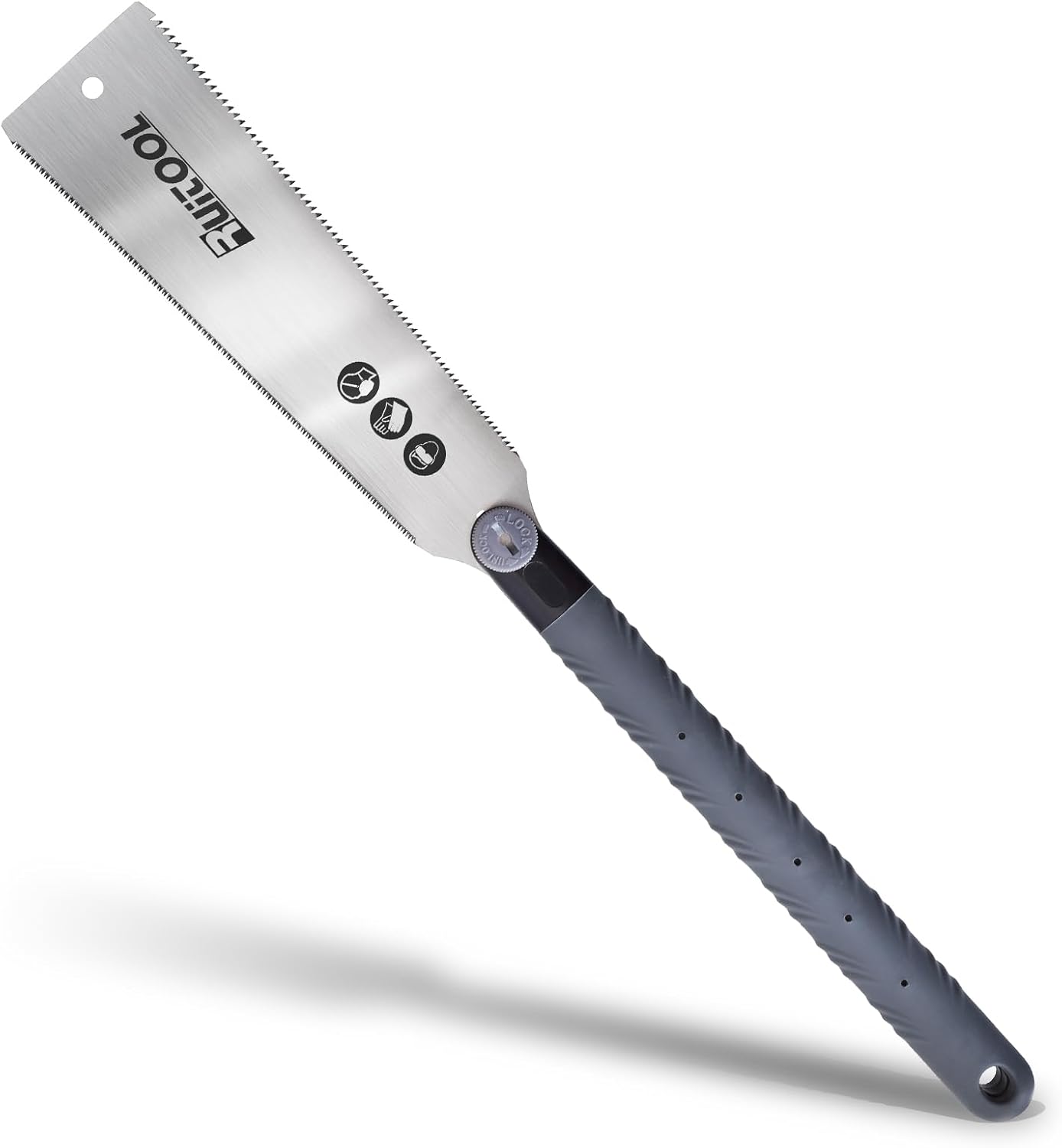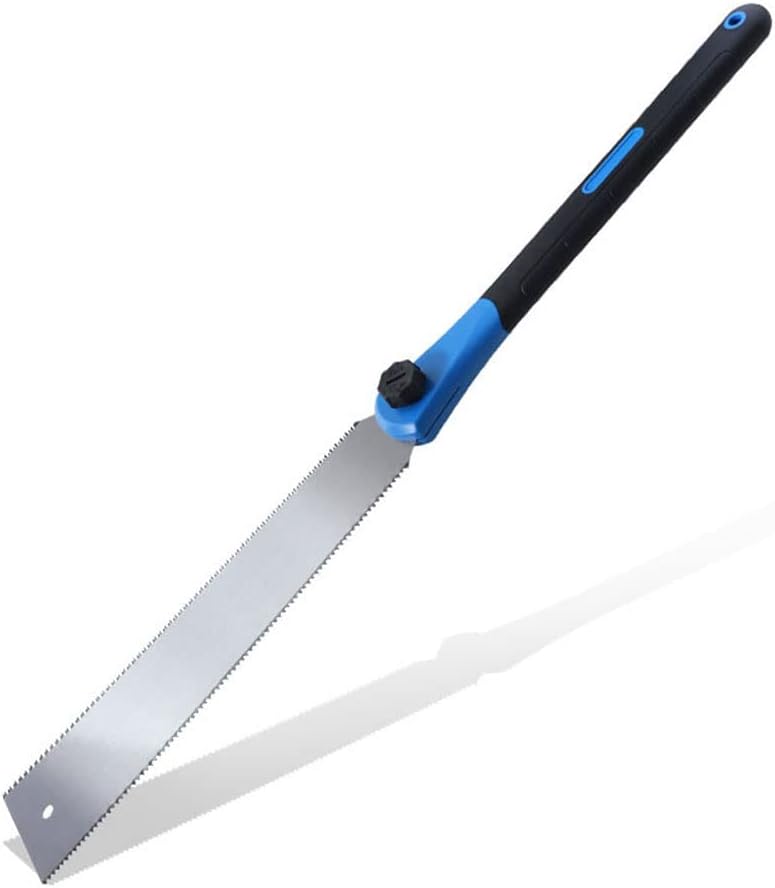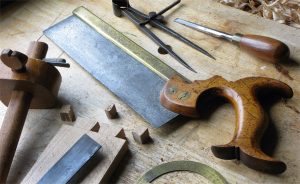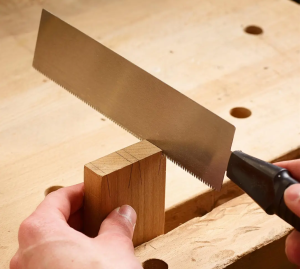Dovetail joints are among the most admired techniques in woodworking—renowned for their strength, elegance, and timeless craftsmanship. Whether you’re building fine furniture, drawers, or decorative boxes, achieving clean and precise dovetail joints requires not only skill but also the right saw.
With so many options available today, from traditional Western backsaws to Japanese pull saws, choosing the best dovetail saw can feel overwhelming.
In this comprehensive guide, we’ll break down everything you need to know about dovetail saws, including what they are, the key factors to consider before buying, and detailed reviews of the best saw for dovetail. By the end, you’ll have all the information needed to pick the perfect saw for your next woodworking project.
Top 5 Best Saws for Dovetails
Below are our top recommendations, each reviewed for precision, comfort, and value.
What is a Dovetail Saw?
A dovetail saw is a fine-toothed backsaw (or Japanese pull saw equivalent) designed for making precise cuts needed to create dovetail joints. Unlike standard saws, dovetail saws feature:
- Thin, sharp blades: Allowing for smooth and accurate cuts.
- High tooth-per-inch (TPI) count: Typically between 14–20 TPI, giving clean kerfs ideal for fine joinery.
- Stiffened spine (for Western saws): Provides stability, preventing the blade from flexing.
- Pull-stroke design (for Japanese saws): Ensures cleaner cuts with less effort and blade wobble.
Because dovetail joints rely on tight-fitting pins and tails, the saw’s precision directly impacts the strength and look of your finished work.
Key Factors to Consider When Buying a Dovetail Saw
Choosing the right dovetail saw is one of the most important decisions you’ll make as a woodworker, especially if you want your dovetail joints to look sharp and fit tightly.
While skill and practice matter, the saw itself plays a huge role in achieving clean, accurate cuts. A poor-quality saw can wander off the line, leave rough kerfs, or even cause frustration that slows down your progress.
To help you make an informed choice, here are the key factors you should evaluate before buying a dovetail saw.
Blade Type: Western vs. Japanese
The first decision is whether you prefer a Western-style dovetail saw or a Japanese saw. Both are excellent for dovetail work, but they differ in design and cutting style:
Western Dovetail Saws
Western saws cut on the push stroke, which means you apply pressure as you move the saw forward through the wood. These saws usually have a rigid spine (back) that reinforces the blade, keeping it straight and preventing flex.
They are excellent for woodworkers who value tradition and want a saw that feels solid in the cut. However, they require more control, especially when starting the cut, because pushing can cause the blade to bind if not perfectly aligned.
Japanese Dovetail Saws (Dozuki or Ryoba)
Japanese saws cut on the pull stroke, which pulls the blade taut instead of pushing it. This allows for thinner blades and finer kerfs, making them highly accurate. A Dozuki saw has a rigid spine and excels at delicate, fine joinery like dovetails.
A Ryoba saw is double-edged, offering both rip and crosscut teeth in one tool, which makes it versatile. Japanese saws are often recommended for beginners because the pull motion feels more controlled and less likely to wander.
Which should you choose? If you’re new to woodworking, a Japanese Dozuki may give you the best results quickly. If you prefer traditional tools or already have experience with Western saws, a Western backsaw might be more satisfying.
Tooth Count (TPI)
The teeth per inch (TPI) on a dovetail saw directly impacts how smooth and fast it cuts.
- High TPI (14–20): These saws cut slowly but produce extremely fine, smooth kerfs. They’re ideal for dovetail joints, especially in hardwoods like oak, maple, or walnut, where clean edges are crucial. The high TPI also reduces the chance of splintering.
- Lower TPI (10–12): These saws cut faster but leave a rougher edge. While they can still be used for dovetails, they are better suited for general woodworking tasks where speed matters more than precision.
For most dovetail work, a saw with 16–20 TPI strikes the perfect balance between control and smooth results.
Blade Thickness & Kerf
Another important factor is the thickness of the blade and the resulting kerf (the width of the cut).
- Thinner Blades: Japanese saws typically have ultra-thin blades, which means they remove less material, leaving you with tighter-fitting dovetails. This precision is why many woodworkers prefer them. However, thin blades can be fragile and may bend if misused.
- Thicker Blades: Western dovetail saws generally have thicker blades, which makes them sturdier and less prone to bending. They remove slightly more material, but they’re durable and can handle hardwoods without worry.
If your primary goal is accuracy and tight joinery, a thin-bladed saw is the best choice. If you need durability and versatility, a thicker blade may be more practical.
Handle Comfort
Since dovetail cutting requires careful, repetitive strokes, the handle of your saw plays a big role in comfort and control.
- Western Handles: Most Western saws have pistol-grip handles made from hardwood or plastic. They fit naturally into the hand and give you leverage during push strokes. However, if not well-made, they can cause wrist fatigue.
- Japanese Handles: These saws typically have straight, rattan-wrapped handles that are lightweight and easy to control. The design encourages a relaxed grip, reducing hand strain over long cutting sessions.
Ultimately, comfort is subjective. If possible, hold different saws before buying to see which feels most natural in your hand.
Durability & Replaceability
A dovetail saw is an investment, so consider how long it will last and how easy it is to maintain.
- Western Saws: These can often be resharpened by hand, extending their lifespan indefinitely if you’re willing to learn or pay for sharpening services. However, not all woodworkers want the hassle of maintaining saw teeth.
- Japanese Saws: Many feature replaceable blades, making them convenient. Instead of sharpening, you simply swap out the blade when it dulls. This makes Japanese saws especially beginner-friendly, though replacement blades add ongoing cost.
When evaluating durability, also consider the saw’s materials. High-carbon steel blades are standard for precision, while premium saws may use special alloys or coatings for longevity.
Final Thoughts on Buying a Dovetail Saw
When shopping for a dovetail saw, it’s not about finding the “perfect” saw for everyone but the right saw for your style, budget, and woodworking goals. Beginners often find Japanese Dozuki saws easier to control, while traditionalists may prefer Western backsaws for their solid feel and sharpenable design. Pay attention to tooth count, blade thickness, and handle comfort, and don’t overlook the value of replaceable blades for long-term use.
RAZORSAW 180mm Dozuki Dotsuki Saw

The RAZORSAW Dozuki 180mm is a Japanese pull saw designed for fine woodworking, particularly dovetails. Its ultra-thin blade allows for extremely precise cuts with minimal kerf, making it an ideal tool for joinery work.
The reinforced spine ensures stability, while the replaceable blade adds longevity. Lightweight and easy to control, this saw is favored by beginners and professionals seeking accuracy in hardwoods and softwoods alike.
Key Features
- Blade length: 180mm (7″).
- 25 TPI for ultra-fine cuts.
- Replaceable blade for convenience.
- Traditional rattan-wrapped handle.
Pros
- Extremely clean, thin kerf cuts.
- Perfect for dovetail joinery.
- Lightweight and easy to maneuver.
- Replaceable blade extends life.
Cons
- Not ideal for heavy-duty cutting.
- Blade may feel delicate for aggressive users.
Suizan Japanese Double-Edged Ryoba Saw

The Suizan Ryoba is a versatile double-edged saw featuring one side for rip cuts and the other for crosscuts. This dual functionality makes it an excellent option for woodworkers who want flexibility while still achieving precise dovetail joints.
Its pull-stroke design minimizes blade binding and allows for thin kerfs, while the traditional Japanese handle provides balance and comfort.
Key Features
- Double-edged blade: rip + crosscut.
- Blade length: 240mm (9.5″).
- High-carbon steel construction.
- Traditional Japanese handle.
Pros
- Two-in-one functionality (rip and crosscut).
- Excellent precision for dovetails.
- Smooth, clean kerfs.
- Affordable compared to Western backsaws.
Cons
- Slight learning curve for beginners
- A larger size may feel awkward in tight spaces
KERYE Double-Edged Japanese Flexible Saw

The KERYE Double-Edged Flexible Saw is designed for woodworkers who need versatility and flexibility. Its thin, flexible blade makes it suitable for flush cuts and precision dovetail joinery. With teeth on both sides, users can switch between rip and crosscut functions easily.
It’s lightweight, affordable, and built for accuracy, making it a solid choice for hobbyists and serious craftsmen alike.
Key Features
- Flexible double-edged blade
- 10″ blade length
- Lightweight handle design
- Ideal for dovetails and flush cuts
Pros
- Flexible design for versatile use.
- Dual edges add value.
- Lightweight and easy to handle.
- Budget-friendly.
Cons
- Less durable than premium Japanese saws
- Not as rigid for deep cuts
SUIZAN Japanese Flush Cut Saw

This SUIZAN Flush Cut Saw is a compact, flexible saw designed for detail-oriented tasks, including dovetails. Its thin blade and fine teeth make it perfect for delicate joinery, while its flush-cutting ability allows trimming of dowels and tenons without damaging surfaces. It’s highly maneuverable, making it a favorite for precision woodworking projects.
Key Features
- Blade length: 5″ (compact size).
- Flexible blade for flush cutting.
- 25 TPI for fine detailing.
- Traditional Japanese pull-stroke design.
Pros
- Excellent for fine dovetail work.
- Perfect for trimming and detail cuts.
- Extremely clean kerfs.
- Compact and easy to control.
Cons
- A small blade limits the depth of cut.
- Best suited for detail work, not heavy tasks.
Great Neck 75003 Double-Edged Japanese Saw

The Great Neck 75003 offers an affordable entry point into Japanese woodworking saws. Its double-edged blade provides both rip and crosscut capabilities, making it versatile for dovetails and general joinery. While not as refined as premium Japanese brands, it delivers reliable performance for DIYers and hobbyists.
Key Features
- 10″ double-edged blade.
- High-carbon steel construction.
- Lightweight wooden handle.
- Rip and crosscut versatility.
Pros
- Budget-friendly price.
- Two-in-one functionality.
- Suitable for beginners.
- Good balance between performance and value.
Cons
- Less precise than premium options.
- Blade may dull faster with heavy use.
FAQ Section: Best Saw for Dovetails
When choosing the best saw for dovetail joinery, woodworkers often have common questions about saw styles, blade specifications, and overall functionality. Below, we’ll explore frequently asked questions to help you decide which dovetail saw is right for your projects.
What is best for dovetails, Japanese or Western?
The debate between Japanese dovetail saws and Western backsaws is one of preference, tradition, and cutting style.
- Japanese Saws (Dozuki or Ryoba): These cut on the pull stroke, which means the blade is under tension while cutting. This design allows for thinner, sharper blades and cleaner kerfs. A Dozuki saw, with its rigid spine, is particularly popular for dovetails because it excels at precise rip cuts. For beginners, Japanese saws are easier to control, reduce binding, and produce less tear-out.
- Western Backsaws (Dovetail Saws): Western saws cut on the push stroke and are reinforced with a brass or steel spine. They have a thicker blade than Japanese saws, but are extremely durable and can be sharpened multiple times. They provide a more traditional feel and are excellent for woodworkers who already have a solid sawing technique.
Beginners often find Japanese saws more forgiving, while experienced craftsmen may prefer the control and longevity of Western backsaws. If precision and ease of use are your main goals, a Japanese Dozuki is often the best choice.
Can you cut dovetails with a Ryoba saw?
Yes, a Ryoba saw can certainly be used for dovetail joints. A Ryoba is a double-edged Japanese saw with rip teeth on one side (for cutting along the grain) and crosscut teeth on the other (for cutting across the grain). Since dovetail joints require both rip cuts and occasional crosscuts, the Ryoba is highly versatile.
However, because the Ryoba has a relatively flexible blade without a rigid spine, it may not be as precise as a Dozuki saw, which is specifically designed for fine joinery. A Ryoba is excellent if you want a multi-purpose saw for general woodworking, but if dovetails are your main focus, a dedicated Dozuki may give you crisper results.
Tip: Many woodworkers keep both. They use a Ryoba for larger cuts and stock preparation, then switch to a Dozuki for delicate dovetails.
What TPI is best for dovetail saws?
Teeth per inch (TPI) plays a huge role in cut quality and speed. For dovetail saws, a higher TPI is generally preferred.
- 14–20 TPI: This range is considered ideal for dovetail work. It produces fine, clean cuts that prevent tear-out, especially in hardwoods like maple, oak, or cherry. A 16–18 TPI saw is a versatile choice that balances speed and precision.
- 10–12 TPI: Faster cutting but less refined edges. More suitable for rough carpentry or tasks where precision isn’t critical.
If dovetails are your goal, aim for 16–20 TPI. The higher tooth count slows you down slightly, but the crisp results are worth it.
Do I need a flush-cut saw for dovetails?
Not necessarily. A flush-cut saw isn’t required to cut dovetails themselves, but it can be an extremely useful companion tool.
Flush-cut saws are designed with flexible blades and teeth that don’t damage surrounding wood, making them ideal for trimming dowels, tenons, or pins that extend slightly beyond the surface. For dovetail work, you may find a flush-cut saw helpful when:
- Cleaning up protruding pins or tails after assembly.
- Trimming small imperfections without scratching adjacent surfaces.
- Fine-tuning joints where a millimeter makes a difference.
So while you don’t need a flush-cut saw to cut dovetails, having one in your toolbox can help elevate the finish of your joinery.
Are Japanese saw blades replaceable?
Yes, many Japanese saws—especially Dozuki and Ryoba models—come with replaceable blades. This is one of the biggest advantages of Japanese saws over Western dovetail saws.
- Convenience: Japanese saw teeth are very fine and can be difficult to sharpen accurately. Instead of spending time learning to file them, you can simply swap the blade when it dulls.
- Cost-effectiveness: Replacement blades are generally cheaper than buying a new saw.
- Longevity: The handle and spine last indefinitely, so with proper care, the tool itself can serve you for many years.
For example, the RAZORSAW Dozuki 180mm allows easy blade replacement, extending its usability without compromising performance.
Can I cut dovetails with a regular handsaw?
Technically yes, but it’s not recommended. Regular handsaws have fewer teeth per inch and thicker blades, which leave rough, wide kerfs. Dovetail saws are specifically designed for precision joinery.
Should I sharpen my dovetail saw or replace it?
- Western saws can be sharpened, often multiple times, making them long-term investments.
- Japanese saws are usually not sharpened but replaced instead. The decision depends on your saw type and whether you’re comfortable with sharpening.
Do dovetail saws work on all wood types?
Yes, but blade choice matters. High TPI saws excel in hardwoods, while slightly lower TPI saws may be better for softwoods like pine.
Conclusion
The best saw for dovetails ultimately depends on your woodworking style, comfort, and budget. For maximum precision, the RAZORSAW 180mm Dozuki stands out as the top choice, while the Suizan Ryoba offers unmatched versatility. Hobbyists and budget-conscious woodworkers may find the Great Neck 75003 an excellent starting point.
Investing in the right dovetail saw will not only improve the accuracy of your joints but also enhance the beauty and strength of your projects. With the right tool in hand, dovetail joinery becomes less daunting and far more rewarding.





